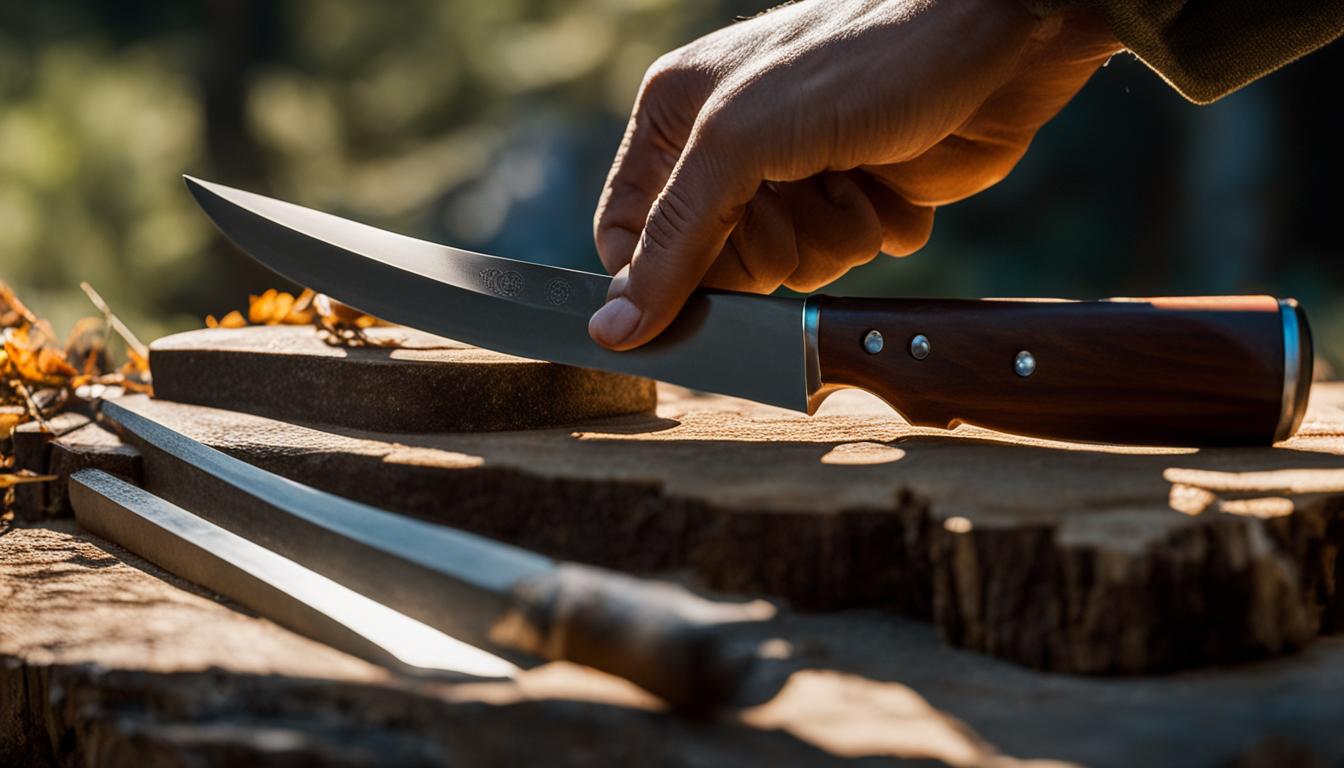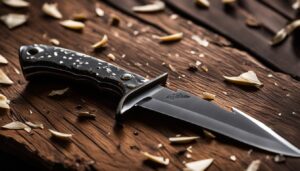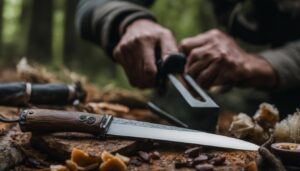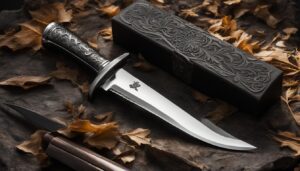As a custom knifemaker, I understand the importance of keeping your hunting knife’s edge razor-sharp. In this article, I will share with you the best techniques for mastering the art of sharpening, debunking the misconception that it’s a complicated process.
When it comes to sharpening your hunting knife, the goal is to reduce the thickness of the leading edge to make it fine enough to cut effectively, while still maintaining its structural integrity. The key to achieving this is using sharpening stones loaded with an abrasive compound. These stones wear away the steel at the cutting edge, gradually sharpening your knife.
One important concept to grasp is the formation of a burr. Raising a burr is a sign that your blade is being sharpened in the right direction. It indicates that the steel at the edge is being pushed to the side, creating a fine, sharp edge. Understanding the importance of edge geometry is also crucial, as it affects the cutting abilities of your hunting knife.
Whether you choose to sharpen your knife at home or in the field, there are various methods you can use. At home, a Norton India combination oilstone or a waterstone can be employed. In the field, you can use a proprietary sharpener with tungsten and ceramic slots or a small rectangle of wet and dry sandpaper glued to scrap ply.
Remember, maintaining the eternal edge of your hunting knife is not just about sharpening. It also involves avoiding abrasive surfaces, taking proper care of your knife, and practicing forgotten sharpening skills. By doing so, you can ensure that your hunting knife remains sharp and ready for action.
Key Takeaways:
- Sharpening your hunting knife is a skill that can be learned and mastered.
- Using sharpening stones loaded with an abrasive compound is the best way to sharpen your knife’s edge.
- Understanding the formation of a burr and edge geometry is crucial for effective sharpening.
- Choose the right sharpening method for your needs, whether at home or in the field.
- Maintain the eternal edge of your hunting knife by avoiding abrasive surfaces and caring for your knife properly.
Understanding the Sharpening Process for Different Hunting Knife Types
When it comes to sharpening hunting knives, it’s important to understand that different knife types require different techniques. Let’s take a closer look at how to sharpen four common hunting knife types: clip point knives, gut hook knives, Bowie knives, and skinning knives.
Clip Point Knife Sharpening
Clip point knives are versatile and great for precision cutting. When sharpening a clip point knife, it’s crucial to take care not to over-sharpen the tip. A straight-edged sharpening stone or honing rod can be used to maintain the blade’s edge. Remember to maintain a consistent angle while sharpening to ensure an even edge along the entire length of the blade.
Gut Hook Knife Sharpening
Gut hook knives are specifically designed for field dressing game. These knives have a unique hook on the back of the blade, which requires special attention when sharpening. To sharpen the gut hook, use a small sharpening stone or rod. Ensure that the edge of the hook is sharpened separately from the main cutting edge to maintain its functionality.
Bowie Knife Sharpening
Bowie knives are known for their length and curve, making the sharpening process a bit more challenging. To sharpen a Bowie knife effectively, a longer sharpening tool is typically required. It’s important to maintain a consistent angle throughout the sharpening process to ensure an even edge. Take your time and pay attention to the entire length of the blade, including the curved section.
Skinning Knife Sharpening
Skinning knives have narrow blades, making them easier to sharpen, but they may require more frequent sharpening due to their thinness and flexibility. To sharpen a skinning knife, you can use a sharpening stone or honing rod. The key is to maintain a consistent angle and apply even pressure during the sharpening process. Keeping your skinning knife sharp is essential for clean and efficient skinning.
By understanding the specific sharpening techniques for different hunting knife types, you can ensure that your blades are always razor sharp and ready for any task in the field.
Exploring Different Types of Sharpening Tools for Hunting Knives
When it comes to sharpening your hunting knife, there are various tools available to help you achieve a razor-sharp edge. Understanding the different types of sharpening tools and their benefits can help you make an informed decision on which one to use for your hunting knife.
Sharpening Stones
Sharpening stones, also known as whetstones, are a traditional and widely used tool for sharpening hunting knives. They come in different materials, such as diamond, ceramic, and natural stones like Arkansas or Japanese waterstones. Sharpening stones require the application of oil or water as a lubricant to facilitate the sharpening process.
Honing Rods
Honing rods are another popular tool for maintaining the edge of a hunting knife. They are cylindrical rods made of steel or ceramic and are used to straighten and align the blade’s edge. Honing rods are typically used in conjunction with sharpening stones to remove any burrs or micro-serrations left after sharpening.
Electric Sharpeners, Pull-Through Sharpeners, and Guided Sharpening Systems
For those who prefer a more convenient and user-friendly option, electric sharpeners, pull-through sharpeners, and guided sharpening systems are available. Electric sharpeners feature rotating abrasive wheels to quickly remove material from the blade, while pull-through sharpeners have pre-set angles and abrasive surfaces to simplify the sharpening process. Guided sharpening systems provide a consistent angle and are suitable for beginners or those who seek precise sharpening.
| Sharpening Tool | Pros | Cons |
|---|---|---|
| Sharpening Stones | Offers control and precision, suitable for various knife types | Requires practice and skill to achieve optimal results |
| Honing Rods | Helps maintain the knife’s edge between sharpenings | Does not remove significant amounts of material |
| Electric Sharpeners | Quick and easy to use, suitable for busy individuals | May remove too much material if not used correctly |
| Pull-Through Sharpeners | Simple and convenient, ideal for beginners | May not provide precise sharpening |
| Guided Sharpening Systems | Ensures consistent angle and precise sharpening | Can be more expensive than other options |
Each sharpening tool has its advantages and disadvantages, so it’s important to consider your skill level, time, and desired level of precision when choosing the right tool for sharpening your hunting knife.
Preparing Your Hunting Knife for Sharpening
Before diving into the sharpening process, it’s crucial to prepare your hunting knife properly. Taking a few simple steps to clean the blade, check for nicks and chips, determine the correct sharpening angle, and choose the appropriate sharpening method will set the foundation for a successful sharpening session.
Step 1: Cleaning the Blade
To ensure optimal sharpening results, start by cleaning the blade of your hunting knife. Remove any dirt, debris, or residue that may have accumulated on the surface. A clean blade provides a smooth surface for effective sharpening.
Step 2: Checking for Nicks and Chips
Inspect the blade of your hunting knife for any visible nicks or chips. These imperfections can affect the sharpening process and the overall performance of the knife. If you notice any nicks or chips, use a file or sharpening stone to smooth them out before proceeding with sharpening.
Step 3: Determining the Angle
Determining the correct sharpening angle is essential to maintain the blade’s shape and cutting efficiency. The optimal angle may vary depending on the type of knife and personal preference. It’s recommended to start with a shallower angle (around 20 degrees) for most hunting knives and adjust accordingly based on the desired sharpness and cutting performance.
Step 4: Choosing a Sharpening Method
There are various sharpening methods available, each with its advantages and considerations. Popular options include sharpening stones, honing rods, electric sharpeners, pull-through sharpeners, and guided sharpening systems. Choose a method that suits your skill level, preferences, and the type of hunting knife you have.
By properly preparing your hunting knife for sharpening, you’ll ensure the best possible outcome and extend the lifespan of your blade. Take the time to clean the blade, check for nicks, determine the angle, and select the right sharpening method. With these steps in place, you’ll be ready to embark on the journey of sharpening your hunting knife and maximizing its cutting performance.
Using a Sharpening Stone to Maintain a Razor-Sharp Edge
When it comes to sharpening your hunting knife, using a sharpening stone is a time-tested method that can help you achieve a razor-sharp edge. While there are many types of sharpening stones available, such as whetstones or oil stones, the basic technique remains the same.
To begin, secure the sharpening stone on a flat surface and hold the knife blade against it at the desired sharpening angle. It’s important to maintain a consistent angle throughout the process to ensure an even edge. Apply light pressure and move the blade back and forth along the stone, alternating between sides.
As you sharpen, you may notice a burr forming on the opposite side of the blade. This burr is a sign that the blade is being sharpened correctly. To remove the burr and refine the edge even further, use a honing rod. Gently run the rod along the blade, applying light pressure to polish the edge. Finally, wipe the blade clean and apply a light coating of oil to prevent rust and preserve the sharpness of the blade.
Maintaining a Consistent Angle for Optimal Results
One of the key factors in sharpening a hunting knife with a stone is maintaining a consistent angle. The angle will depend on the type of knife and the desired cutting performance. It’s recommended to start with a higher angle and gradually decrease it until the desired sharpness is achieved.
Using a sharpening guide or jig can help you maintain a consistent angle during the sharpening process. These guides hold the knife at a specific angle, allowing you to focus on the sharpening technique without worrying about the angle. Alternatively, you can practice freehand sharpening, which requires more skill and experience to maintain a consistent angle.
Summary:
- Using a sharpening stone is an effective method for sharpening hunting knives.
- Secure the stone on a flat surface and hold the knife at the desired sharpening angle.
- Move the blade back and forth along the stone, applying light pressure and maintaining a consistent angle.
- Use a honing rod to remove the burr and polish the edge.
- Apply a light coating of oil to preserve the sharpness of the blade.
Keeping Your Hunting Knife Sharp for Longer Periods of Time
Proper maintenance and regular care are essential for keeping your hunting knife sharp and efficient for extended periods. Here are some key practices to help you maintain the longevity of your knife:
Using a Honing Rod
One effective way to keep your hunting knife sharp between sharpenings is by using a honing rod. A honing rod helps align the blade’s edge, keeping it straight and true. To use a honing rod, hold it firmly and run the blade against the rod at a consistent angle, applying light pressure. Repeat this process several times on both sides of the blade to maintain its sharpness.
Proper Storing of the Knife
Proper storage is crucial to prevent damage and ensure the longevity of your hunting knife. Store your knife in a dry place, away from moisture and extreme temperatures. Consider using a knife sheath or a blade cover to protect the edge from accidental contact and help maintain its sharpness for longer.
Avoiding Misuse
Avoid using your hunting knife for tasks it’s not intended for, as this can significantly impact its performance and sharpness. Using the knife for activities like prying, digging, or opening cans can cause the blade to chip or bend, making it difficult to restore its sharpness. Stick to using the knife for its intended purpose to ensure its longevity.
Regular Sharpening
Regular sharpening is crucial to maintain the sharpness of your hunting knife over time. Depending on your knife’s frequency of use and the tasks it performs, a general rule of thumb is to sharpen the blade after every 10-20 hours of use. Regular sharpening will restore the knife’s cutting performance and prevent the blade from becoming dull and less effective.
By following these practices, you can ensure that your hunting knife remains sharp and reliable for longer periods. Proper use, maintenance, and regular sharpening will help you make the most out of your hunting knife’s performance and keep it in excellent condition for years to come.

Conclusion
Sharpening your hunting knife is a skill that every outdoorsman should master. By understanding the sharpening process, using the right tools, and maintaining the blade, you can ensure that your hunting knife remains at its peak performance.
Whether you choose to sharpen your knife at home or in the field, following the proper techniques is essential. By using a sharpening stone, honing rod, or other suitable tools, you can achieve a razor-sharp edge and maintain the structural integrity of the blade.
Regular maintenance and sharpening will not only keep your knife sharp but also ensure your safety while out hunting. By taking care of your hunting knife and practicing the forgotten art of sharpening, you can enjoy the benefits of a well-maintained blade for years to come.
FAQ
Is sharpening a hunting knife complicated?
No, sharpening a hunting knife is not complicated. The key is to understand the goal of reducing the thickness of the leading edge to make it fine enough to cut effectively.
What is the significance of maintaining the structural integrity of the edge?
Maintaining the structural integrity of the edge ensures the knife remains sharp and efficient for its intended use.
What are the recommended sharpening tools for hunting knives?
Recommended sharpening tools include sharpening stones (whetstones), honing rods, electric sharpeners, pull-through sharpeners, and guided sharpening systems.
How do I prepare my hunting knife for sharpening?
Before sharpening, clean the blade, check for nicks and chips, determine the correct sharpening angle, and choose the appropriate sharpening method.
How do I sharpen a hunting knife using a whetstone?
Hold the stone securely on a flat surface, place the knife blade against it at the desired sharpening angle, apply light pressure, and move the blade back and forth along the stone. Alternate between sides and gradually increase pressure until the desired sharpness is achieved. Use a honing rod to remove the burr and polish the blade edge.
How do I keep my hunting knife sharp for longer periods of time?
Use a honing rod to maintain the blade’s edge between sharpenings, store the knife in a dry place away from humidity and extreme temperatures, avoid using the knife for tasks it’s not intended for, and regularly sharpen the blade.





